Product-Led Marketing
10 mins read
Product-Led Growth Adoption Playbooks for Early- & Growth-Stage SaaS


Victor Eduoh
Lead Strategist @VEC
I risk coming off as too generalistic, but I’ll still go on to say…
Selling your software today is almost no different from selling common consumer goods. As an early- or growth-stage SaaS executive or VC, you may disagree.
And why wouldn’t you?
It costs thousands or millions of dollars to build your software. So how could selling it be likened to selling a pair of shoes?
Well, lemme ask you.
Have you ever paid for a consumer product, only after trying it and loving how it made you look or feel?
I bet you have.
Think about test-driving cars or trying outfits on to see if you’ll like them. You had less trouble paying after checking them out, right?
Good.
Product-Led Growth brings that same ease to selling software.
It’s a SaaS go-to-market strategy that can make it easier to sell your product after giving prospects a fair taste of it first.
But I’ll also admit.
Using a free version of your product as the primary driver to unlock sales is no stroll in the park. Most early- and growth-stage software companies can relate to this.
You need practical playbooks to guide its implementation.
And that’s what you’ll get in this guide – VEC’s admired approach to adopting Product-Led Growth:

I’ll start with the basics.
But you can navigate to the playbooks below
What I’ll Cover
- What a Product-Led Growth Approach Is (and Why It’s Unique)
- Is PLG a Future GTM Strategy for Growing SaaS Startups?
- Product-Led Growth Playbooks for Early/Growth Stage SaaS
- Final Thoughts: Adopting Product-Led Growth Boils Down to Two Things
…
What a Product-Led Growth Approach Is (and Why It’s Unique)
Quick question for you.
What’s not so unique about how consumers discover and buy things?
I’ll tell you.
Consumers, like you and me, carry their needs and problems with them everywhere they go. Deep down in our hearts, we know our needs or the problems we want to solve.
So whenever or however we find a solution, we’re more likely to pay (with less trouble) once we can test that it works well.
This pattern, which isn’t unique to buying consumer goods, makes PLG unique to unlocking SaaS sales.
Product-Led Growth appeals to that inherent end-user or consumer-like behavior all human beings have.
It calls for company-wide software development efforts to focus on getting your product into the hands of end-users first.
This strategy says:
Don’t try to convince key stakeholders via massive sales-led or marketing-led outbound campaigns.
Instead, focus on giving end-users a fair taste of your product.
OpenView Partners, the VC firm who coined the term, calls it the unique bottoms-up (against the top-down) approach to selling software.
And rightfully so.
Let’s face it.
Gone are the days when IT managers and executive stakeholders forced all software on their teams after golf events. The PLG approach is in line with how organizations adopt software today – getting input from actual users.
Based on this rising trend, which AppCues calls the consumerization of SaaS…
PLG says, make it easy for actual users to adopt and test your software (via freemium or free trial motions). Then, ensure they experience meaningful value that they’re happy with the fair taste you give them.
What does your company gain when this happens, you ask?
- First, it becomes a no-brainer for users to tell others about your product – meaning more organic, word-of-mouth exposure. And to upgrade as it becomes more integral to their work.
- Also, you get a better chance of top management approving budgets for company-wide adoption at organizations where those end-users work.
- Last but not least, you open up your funnel, get factual data to refine your ICPs based on who is getting value out of your product. This, in turn, arms relevant teams in your company with accurate data to reach out and close more sales.
PLG makes all these possible because, as OpenView’s 2020 SaaS Expansion Benchmarks excellently observed:
“Once [end-users] reach their “aha” moment with [your] software, [it] becomes mission-critical, and it’s nearly impossible to go back to the old way of doing things.”
How the Product-Led Growth Model Works (and Its Principles)
To demonstrate the working principles of the PLG model, hear from Jfrog, a company fully practicing the Product-Led approach.
In its 2020 S-1 filing, OpenView picked up relevant quotes, exposing how the company drives consistent growth via the PLG model:
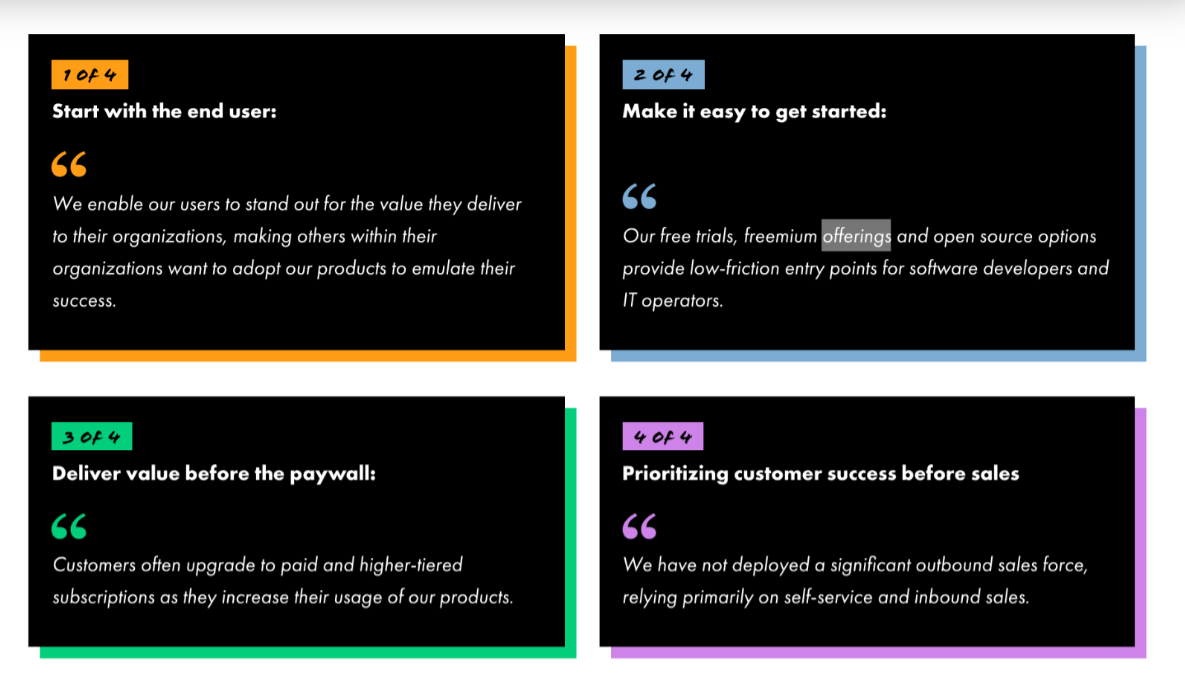
These quotes show the PLG model working on four principles:
- Start with end-users (prioritize the actual people who’d use your software).
- Make it super easy for users to sign up (think freemium, free trials, smoother onboarding).
- Give value before you take (don’t just allow users to test your software, ensure they get meaningful value).
- Put customer success above sales (treat free or trial users like customers and ensure they’re successful with your product).
As a founder, marketer, or VC for an early/growth-stage SaaS, you may want to consider PLG only if it’s the future of growing your business.
Is it?
Is PLG a Future GTM Strategy for Growing SaaS Startups?
Yes!
And I didn’t come to this conclusion based on intuition alone. PLG is the driving force behind the incredible growth of famous SaaS brands today.
Since 2012, more and more SaaS brands have leaned on Product-Led Growth to achieve high growth.
Take the likes of Pagerduty, Dropbox, Datadog, Slack, Zoom, and many others, for instance.
They all used it to grow into enterprise/IPO status:
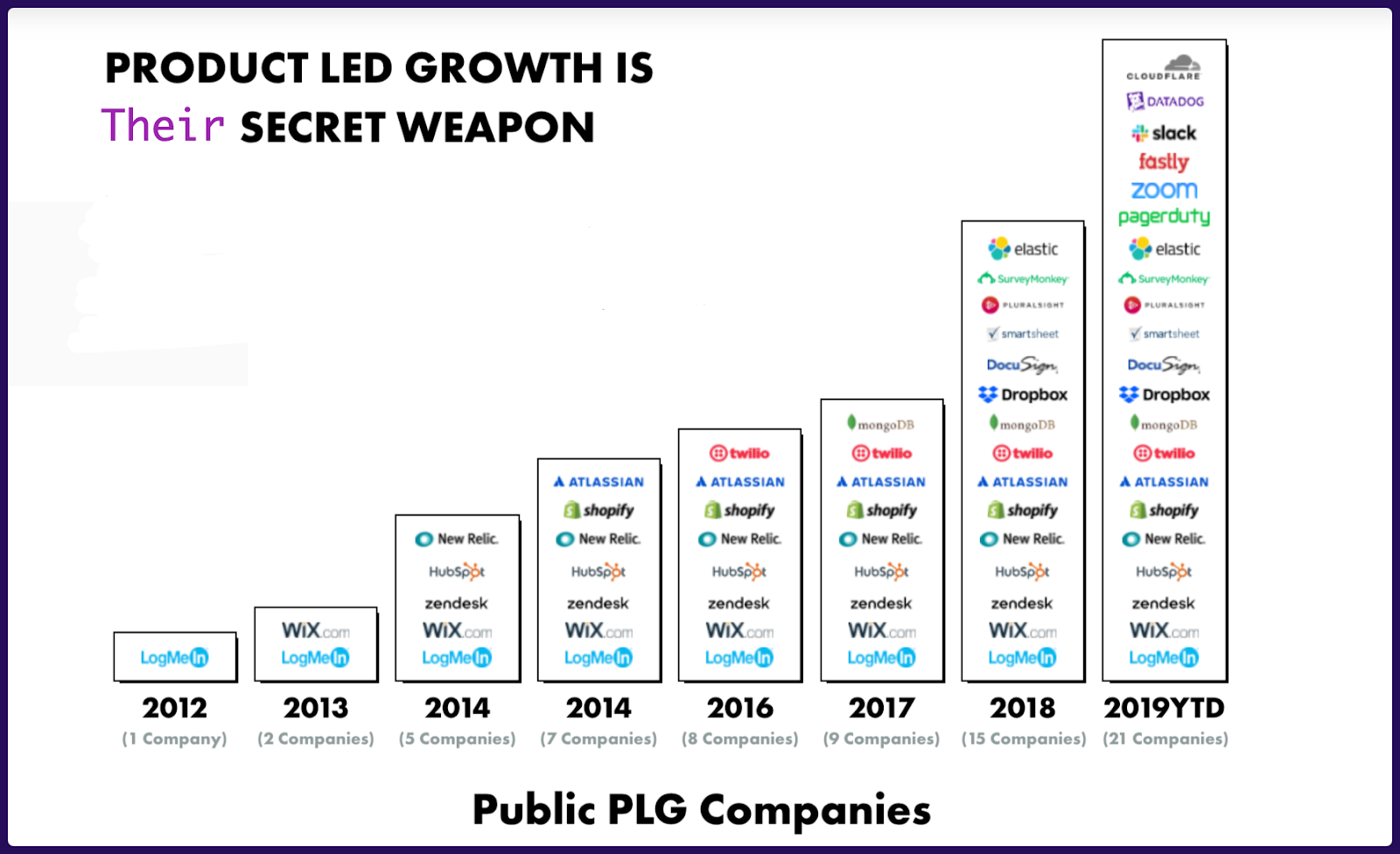
[source]
Beyond this, recent studies on how B2B customers buy software also favor PLG as the future strategy for driving SaaS growth.
Take TrustRadius’ 2021 Buyers Disconnect Study.
As per its findings, software buyers today (over 87%) want self-serve. That is, during research, they prefer to try and see how a product works before talking to reps:
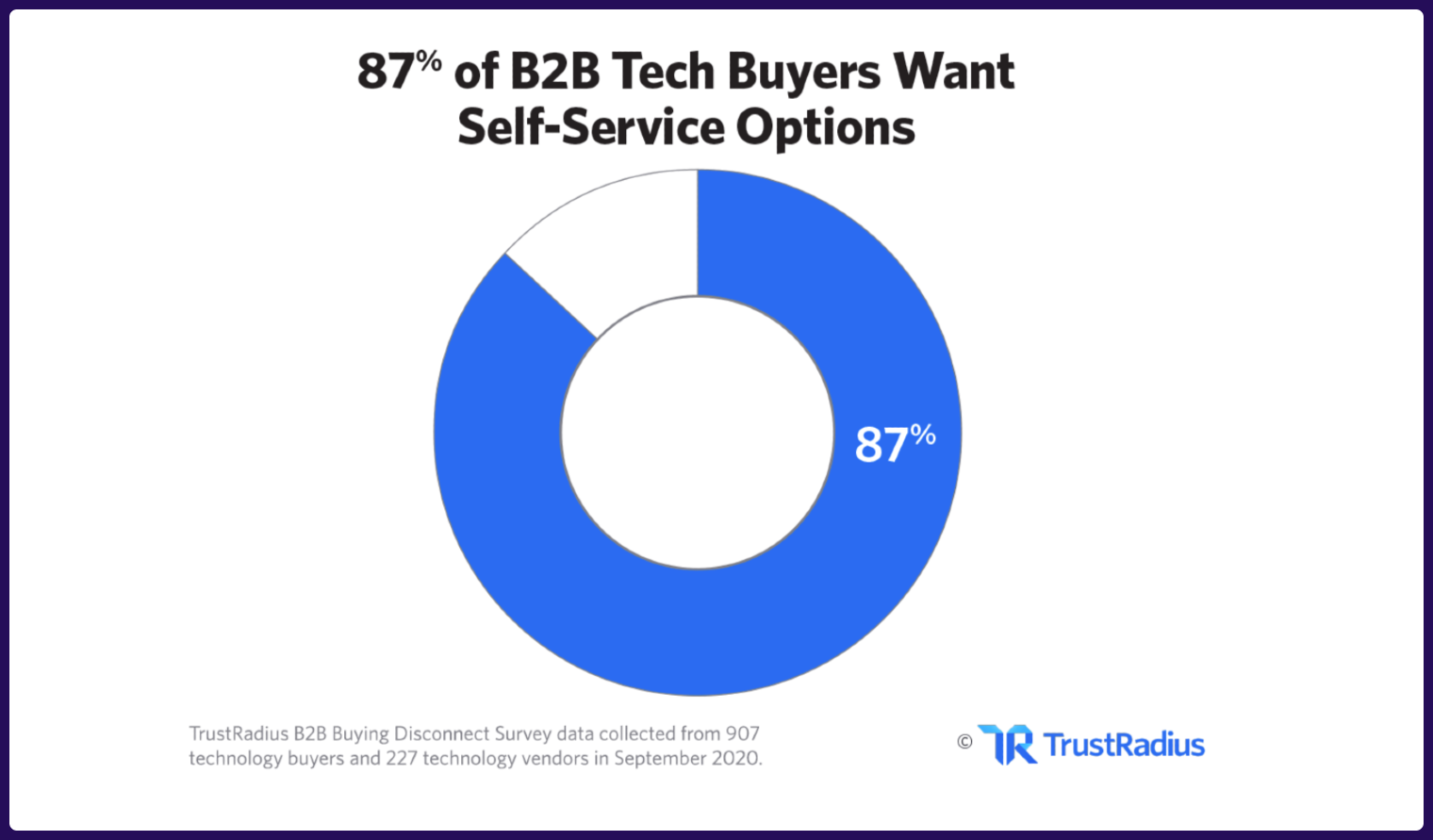
[source]
The question then is, what are the best ways to give prospects self-serve options or experience?
You do this via free trials/freemium accounts, product demos, and positive user reviews (achieved by putting customer success above sales).
PLG principles capture all that.
I highlighted these in Jfrog’s enviable growth earlier.
But to further show PLG is the future strategy for growing SaaS businesses, let’s also turn to LinkedIn’s Rethink B2B Buyer’s Journey research.
The study’s findings were similar to those by TrustRadius.
It found what the most effective B2B sales content had. They were product features and functions (shown best via free or trial accounts), demos, and varying types of user reviews (again, gotten as users access and test your product):
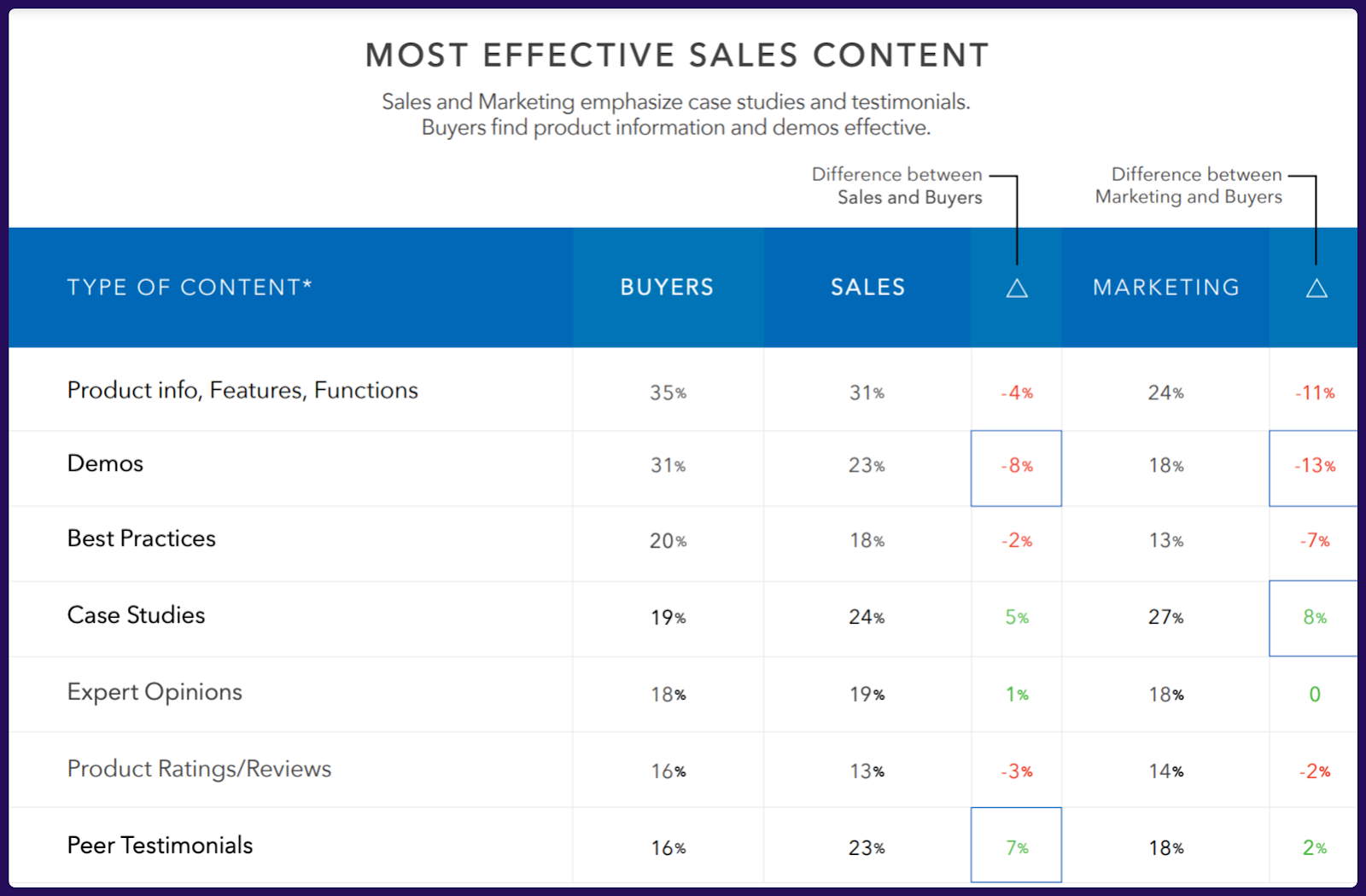
Do you see the pattern so far?
First.
PLG is the go-to-market strategy many high-growth SaaS brands hitting enterprise/IPO status now rely on.
Second.
It offers the most trusted and influential info sources (self-serve options) used by B2B tech buyers when evaluating software today.
Third.
As per LinkedIn’s study, it’s also the approach that suits the most effective B2B sales content.
Put all these together, and PLG is a strong case as the future of growing your SaaS business. However, these aren’t the only reasons why Product-Led Growth is increasing in importance.
Let’s see.
Two Pertinent Reasons Product-Led Growth Will Become Even More Important
Whenever Microsoft releases a quarterly report, its highlights are usually the increase in share price and revenues.
That wasn’t the case on April 30th, 2020.
What most mainstream media picked up from that report weren’t increases in revenue or shares. The highlight was on this remark by Satya Nadella:
“We [saw] two years’ worth of digital transformation in two months.” As you’ll know, this was due to the WHO-declared covid-19 pandemic.
I brought this up for two reasons.
One.
It’s such a great time to have your product in the SaaS industry. That’s because global growth in digital adoption naturally implies more people and organizations will adopt more software.
As you can see below, this massive adoption is rapidly increasing the SaaS market size and revenue opportunity worldwide:
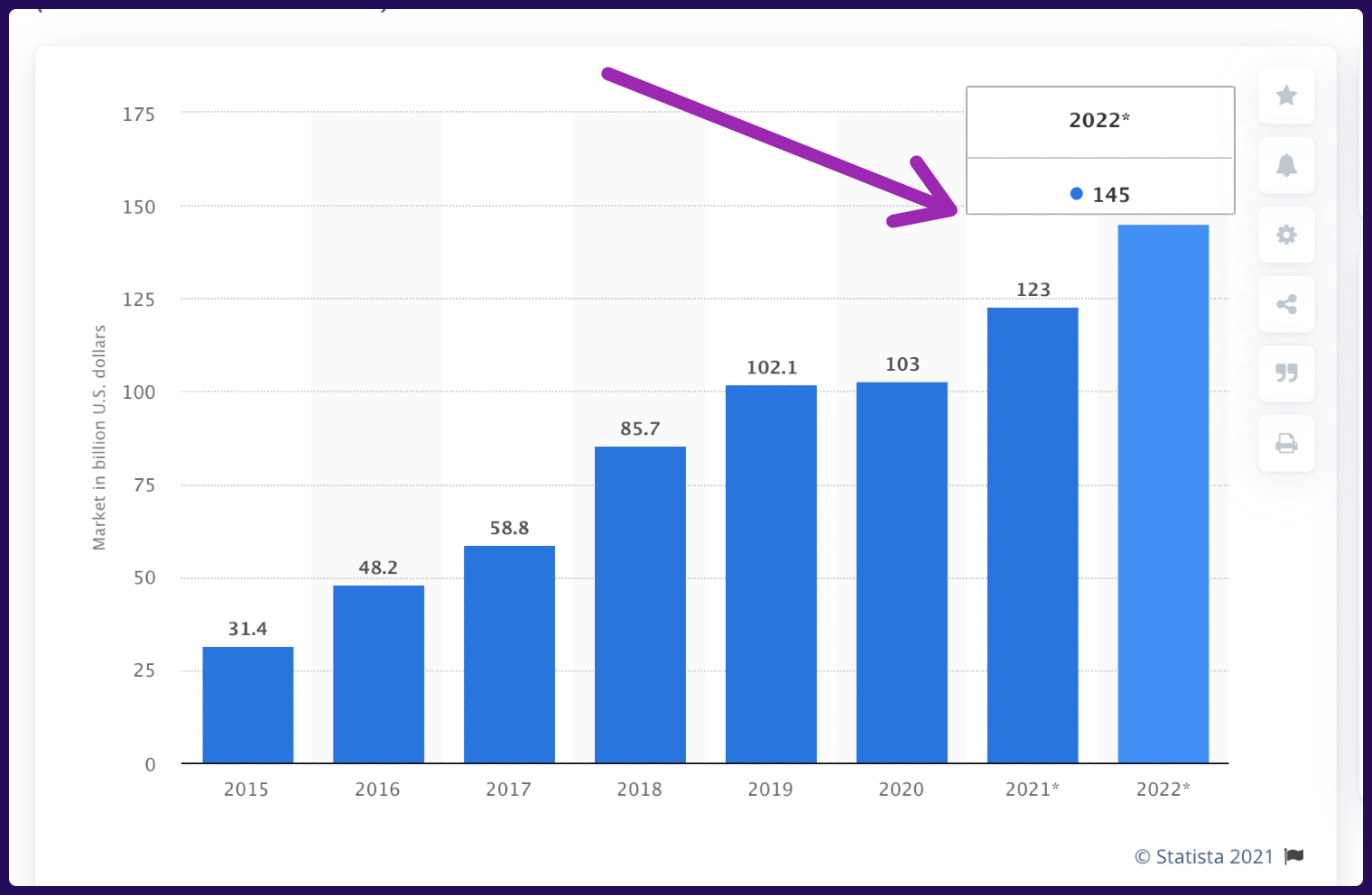
[source]
However, this increasing market size (expected to reach $145 billion by 2022) brings us to the second reason why PLG will become even more table stakes.
Fiercer competition!
As of June 2020, there were about 15,529 SaaS companies (up from about 3,731 in 2010):
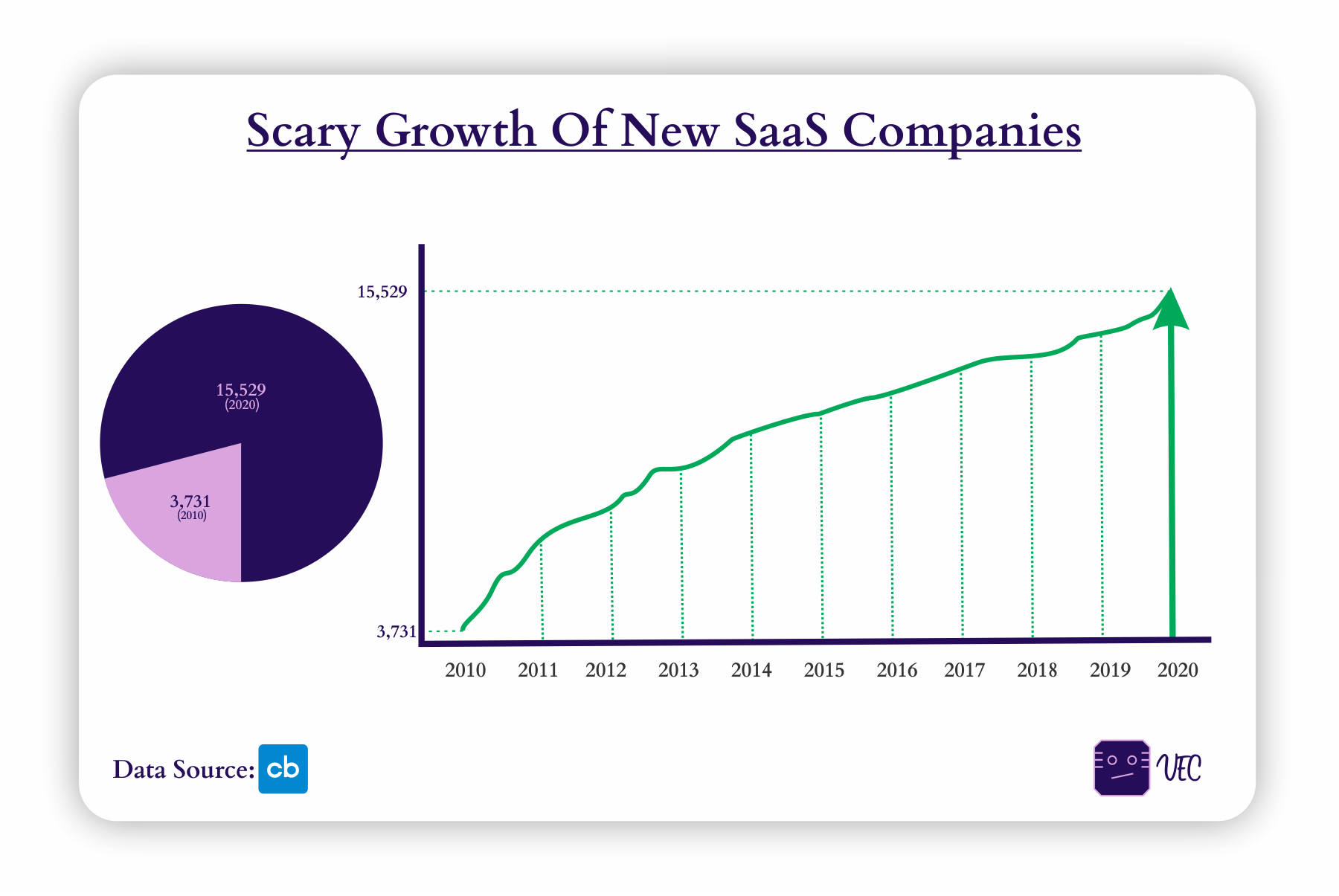
If the graph and figures don’t scare you, the next ones should.
In 2012, SaaS firms had an average of three direct competitors. By 2017, that number grew to nine companies competing for the same customers in the same segment.
Take SaaS marketing solutions, for example.
The number of products in this segment alone went from 500 in 2007 to 8,500 by 2017. This number is growing higher as you read this.
It’s why Patrick Campbell, CEO ProfitWell, started the study referenced above by saying:
“Competition is increasing. Your customers are expecting more from you. The relative value of your features is declining.”
To make sense of all these, I have a quick question.
Assume you had to choose one out of 9 SaaS products offering the same value, as is about the case today. What information sources will you trust the most when evaluating these options?
I can guess your answer.
And that’s because if you’re like other software buyers interviewed by TrustRadius, you’ll prioritize:
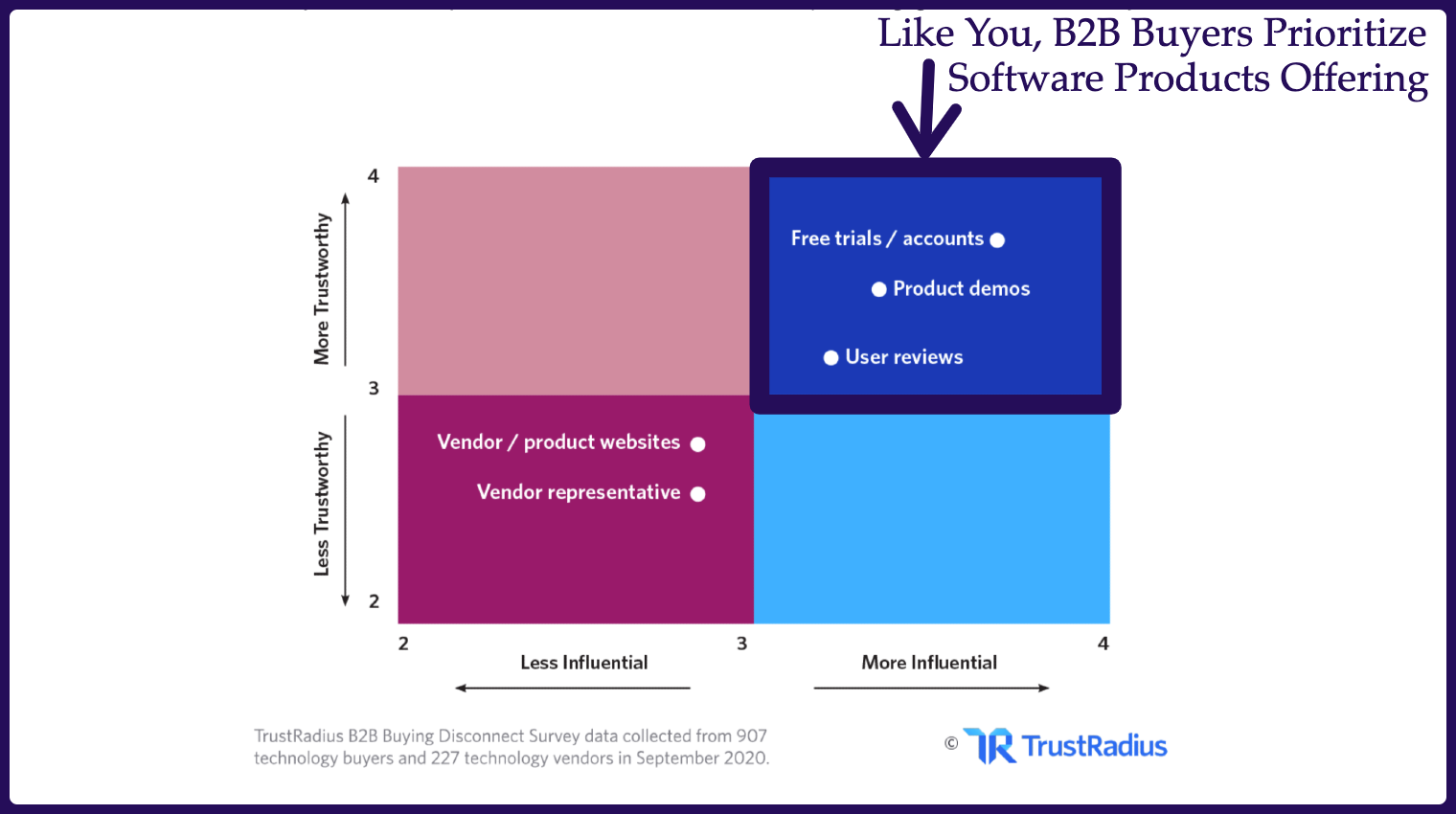
[source]
Do you now see why I said selling software is like selling regular consumer goods at the beginning of this guide?
Good.
Due to the increase in options (like consumer goods), prospects also want to try software (to see which one works best for them) before they commit.
There’s a massive change in how people evaluate software today.
And it will only increase as more options enter the SaaS industry. This dire situation led Patrick (cited earlier) to say:
“The strategies you’ve used to grow your company for the last five years aren’t going to work for the next five years. You can either adapt to the new SaaS economy or fall behind.”
Patrick’s statement comes down to this:
To achieve your present and future marketing and sales goals, you need a new SaaS go-to-market strategy that works with a freemium model.
And that’s one with a self-serve, product adoption motion that allows you to give prospects:
- Trial and freemium accounts
- Product demos, making it easier to collect real
- User reviews.
Product-Led Growth makes all these possible. That’s why its importance will continue to increase going forward.
We’re getting closer to the main focus of this guide. But first…
Is PLG Right for Your Early/Growth-Stage SaaS?
Before we find out…
Product-Led Growth requires upfront costs. You need to have built something pretty solid before you can give trial/freemium users access to take it for a spin.
First are the server uptime and self-serve product development costs.
Then, some support beyond product documentation to ensure free users get value out of your product. All this is because PLG mandates you treat free users like they pay to use your product.
Else, not only will they move to test the next free option, but they’ll spread bad reviews. And this will undoubtedly hurt your acquisition plans.
If these downsides seem too much for you to handle, PLG isn’t for you.
But if you’re building software for how people prefer to buy it today, you have less of an option. This means you must account for these costs and go with a Product-Led Growth strategy to survive.
It’s the harsh reality early- and growth-stage SaaS companies must face today.
On the bright side, data shows you’re better off with a PLG strategy.
Once you weather the initial storms, Product-Led Growth companies grow faster than their SaaS peers:

[source]
But how do you weather the initial storms, successfully adopt PLG, and grow your SaaS business?
Good question.
The rest of this guide will introduce VEC’s practical playbooks to adopting and succeeding with PLG. These playbooks come from our experience working with early- and growth SaaS companies (and the VCs backing them).
But they can work for others too.
Product-Led Growth Playbooks for Early/Growth Stage SaaS
Disclaimer alert.
One.
The playbooks you’re about to go through are practical guides and will come in real handy. But they aren’t magic or silver bullets.
They won’t transform a mediocre product overnight. If your product sucks (by that, I’m asking, does it solve real customer pains?), go back to the basics.
Two.
I’m sharing with you my (and my VEC’s team) experiences working with early/growth-stage SaaS. Of course, I supplemented with some interviews and deep research observing what works best in a classic PLG setting.
As you’ll agree, experiences differ, as no two situations are precisely the same.
So apply these playbooks with a grain of salt. And where you need clarification, do some experimentation or seek the right execution expertise.
Wisdom, they say, is abundant amid counsel.
With that said, I’d start with the most important playbook to successfully adopt PLG in an early- or growth-stage SaaS startup.
And it’s aligning your entire team on a singular focus.
Let’s dive in.
1. Team Alignment Playbook: The Product-Led Single Point of Truth
Product-Led Growth widens the top of your funnel for good.
And I don’t mean for more vanity metrics like traffic or leads (MQLs or SQLs). I’m talking about real users and potential paying customers signing up to take your product for a spin.
Call them Product-Qualified Leads, PQLs.
But having random people jump right into using your product without going through “lead” qualification or sales cadences has its downsides.
It raises questions like:
- Who should first touch base with users?
- When should they do it?
- Should it be the marketing, sales, support, engineering, or success team?
The truth is that there’s no one-size-fits-all answer to these questions. When and what team should go first depends on various factors:
- Who is the user?
- What ideal customer profile (ICP) does the user fall into?
- What’s the user trying to accomplish?
- Are they having problems setting up their accounts or integrating with 3rd party software to reach your product’s “aha” moment?
- Perhaps there’s a bug stopping users from going from point A to B?
- And many others.
In a PLG motion, you can’t provide effective answers to prospects’ questions in silos. Neither should you assign one team to tackle each in a silo.
And that’s because each question touches on another in some way.
Users, even though they haven’t paid for your product, still expect all the right answers when trying your product. Fail to remove all adoption roadblocks, and you can kiss your acquisition goals goodbye.
So, how do you ensure your marketing or sales team doesn’t reach out to users when a bug in your product is the problem? How do you help all team members make the right decisions based on users’ and product interactions?
You must become bullish on cross-functional team alignment.
And that’s where the Product-Led Single Point of Truth playbook comes in.
In a PLG business, everything revolves around your product.
Your marketing team activities may create awareness, but an excellent product experience is how you acquire new users. The faster you get new users to meaningful value points, the faster you’d succeed in getting them to upgrade, expand accounts, or become fans.
But to stand a chance…
Your entire team (irrespective of structure) must have a singular focus on what matters most – how the product and users interact:
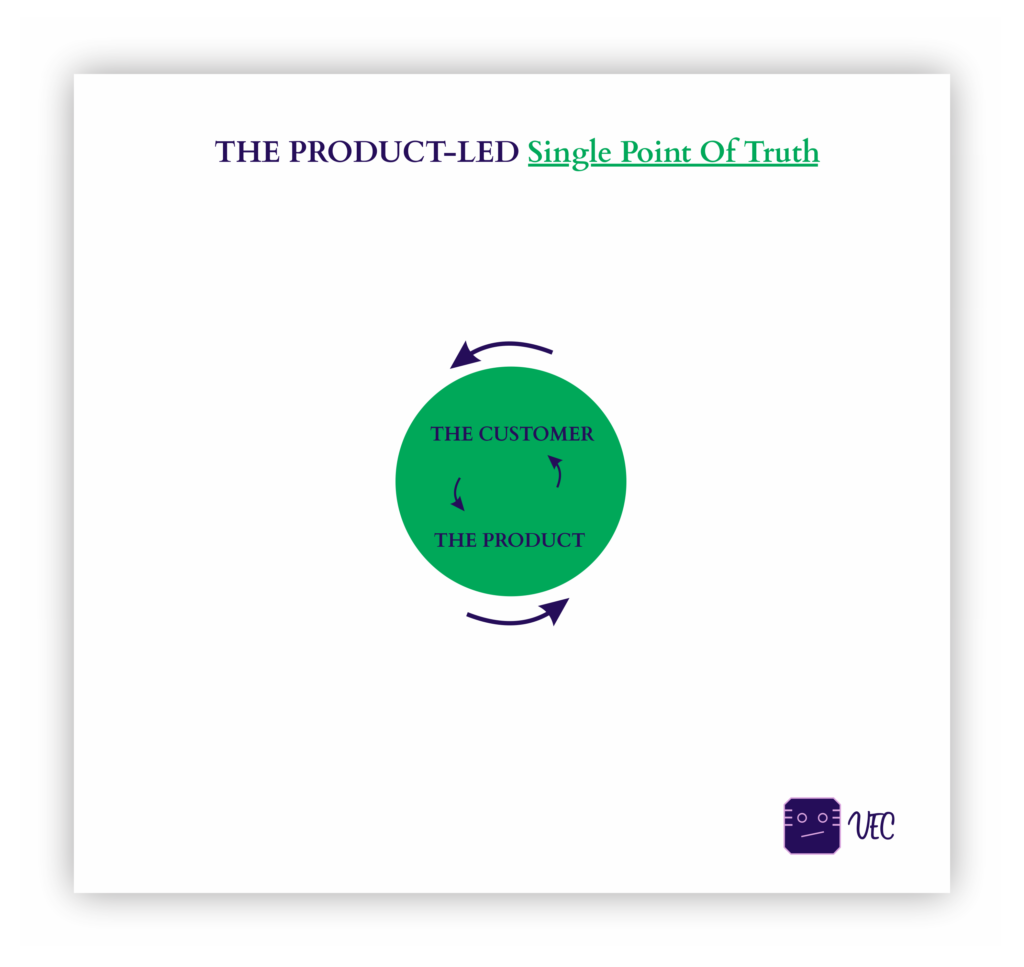
This always-evolving union between users (whether new or existing) and your product is what I call the “Single Point of Truth.”
Your teams’ attention must always be on this evolving union.
And that’s because such a unified focus makes correct data on how prospects use your product and vice versa available to them.
But it doesn’t end there.
It’ll also help each team to align themselves in the best way possible, taking positions where data most relevant to their functions reach them faster.
And where the interchange of that data is seamless between teams. In an early- or growth-stage startup, teams wear different hats.
So a possible team structure may look like this:
With the right team positioning, alignment, and bullish focus on users and your product across your organization, there’s less confusion.
Each team gets real-time data and knows when to step in to help users. Doing this helps to reduce a user’s time to value or optimizing the product to deliver value.
Your team will also find it easier to make decisions and know when (or how best) to pivot the product.
Jessica Box, Lintree’s Head of Growth, acknowledged this in an interview with Max Duce of Product-Led Alliance:
“I find it a lot easier to make decisions in a product-led company because it’s very clear, you have a lot of data at your disposal to make the decisions on how to build products and what to build next.”
And there’s more proof.
Laura Erdem is a Senior Account Executive at Dreamdata.io, a B2B revenue attribution platform. She told me such an alignment helps her company’s teams know when to act.
In a video call with me, she said:
“With the focus on the interaction between users and the product, there’s cross-collaboration within the team. Everyone is looking at new users coming to the product to identify our ICPs since we get different prospects.
“It’s how we determine who does what based on how users adopt the product. Should it be sales, customer support, success, or the other teams?”
She made a valid point.
The Product-Led Single Point of Truth playbook gives your team the focus and alignment needed to answer the questions we asked earlier:
- Who should first touch base with users?
- When should they do it?
- Should it be the marketing, sales, support, engineering, or success team?
Once you’ve aligned your teams’ focus using the Product-Led Single Point of Truth playbook, making real-time product data available to them is easy.
You only need to adopt excellent product analytics and SaaS onboarding tools.
For the latter, I recommend Mixpanel based on numerous 5-star reviews like this one by Jeff Parker, VP of Product Strategy at Quicken Inc.:
“The data we get from Mixpanel is vital to what we do, every day. Teams across the company are able to answer their own analytics questions easily, without any developer skills.”
And for onboarding, I’ll go with UserGuiding based on this review by GetCanopy’s Creative Director, David Palmer:
“We wanted a solution that could do really well in the user onboarding vertical. We’ve used Intercom, WalkMe, and Pendo; but they were trying to do so many things at once it felt overwhelming. UserGuiding felt like a simple strategy that we could easily adopt for our solution, and we ended up decreasing our support load by 20% with UserGuiding.”
Now, using the Product-Led Single Point of Truth playbook has other benefits.
One of them, and a very crucial one, is its flexibility:
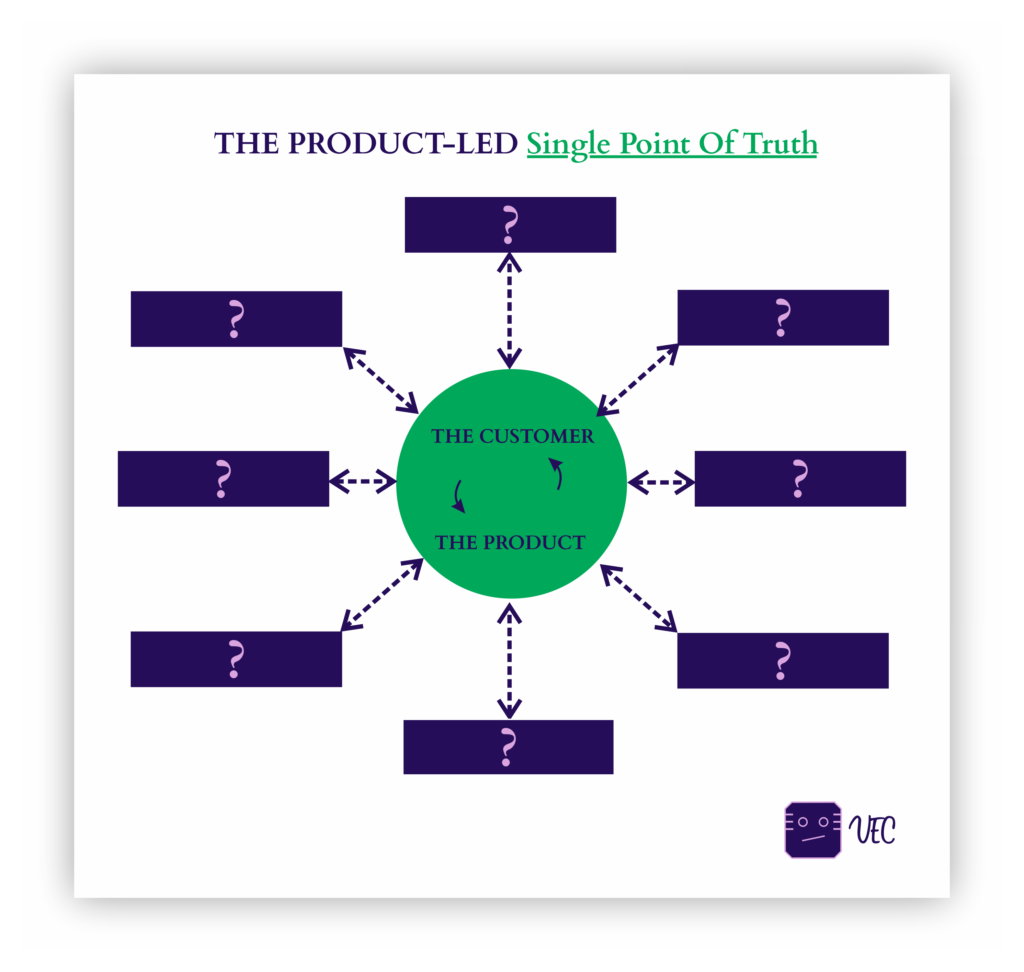
As you adopt PLG, you can adjust and expand your team structure based on how your early- or growth-stage SaaS company expands:

After establishing a lean focus on users and your product and aligning your entire team (no matter how big), what should come next?
It’s attracting the right audience.
But it’s not enough to just attract your target audience. Or generate traffic. You must also do it in a way to directly convert them into trial or freemium users.
Allow me to introduce the PLG playbook that’d help you achieve both.
Product-Led Storytelling.
2. Attracting & Converting Users Playbook: Product-Led Storytelling
Naman Khan is the CMO at Zeplin.
In an excellent piece by Kyle Poyar titled, “Who Actually Owns Growth In A PLG Company,” Khan said:
“The product is an amazing growth engine. Valuable features & relevant content are the fuel. If you put the right fuel in the engine, amazing things can happen.”
Let’s unpack two crucial points from Khan’s statement for a second.
One.
To drive real growth with your product (to adopt product-led truly), you need features valued by users.
It’s how you’d solve their problems.
The more of the right features fueled into the product, the more you’d retain and expand users.
A lean focus on the interaction between users and the product, which you can achieve with the Product-Led Single Point of Truth, will help you do that.
Two.
To attract new users and ignite consistent growth, new people must hear and discover your product and the fantastic features you develop. According to Khan, you achieve this by fueling your product with the right content.
But content isn’t king anymore.
Almost all SaaS companies are doing content. Those who manage to rank content generate scores of traffic (and email addresses disguised as“leads”) with nothing else to show.
There has to be a better way. It’s why Khan emphasized relevant content.
Relevant content, as Khan highlights, must attract new people who need your product and its features. But it goes beyond attracting your target audience. It also goes beyond collecting their emails (hello “leads’ & MQLs).
This content should directly convert the traffic and attention it brings to your product into new users or fans, at least.
As you adopt PLG, the Product-Led Storytelling playbook is your guide to crafting this kind of content Khan recommended.
Alex Birkett, former Growth Marketing Manager at HubSpot, agrees:
“[SaaS] content marketing is clearly a powerful way to grow [your] business.
“But I believe you can shortcut the commonly prescribed route of converting content readers to your email list. I think you can use content to acquire product users directly. It just takes a little effort and foresight.”
The Product-Led Storytelling playbook brings that needed foresight.
See it as a product-focused twist to content marketing. And the foresight required to execute it involves crafting relatable stories, showing well-defined ideal customer profiles how to overcome defined challenges with your product.
Do it well, and each SaaS content you craft does three things:
- It will attract and filter the right audience,
- It will engage and show them how your product solves their problems,
- It will persuade and directly convert them into new users or fans:
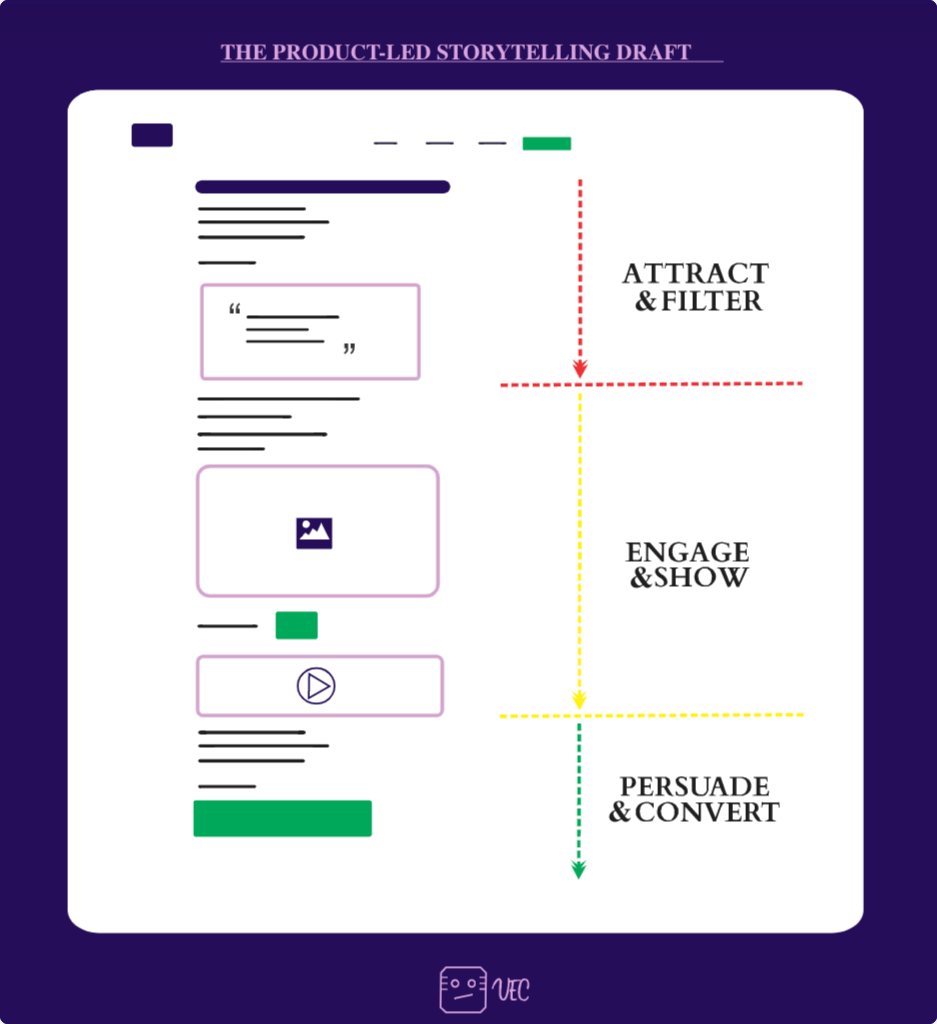
And by doing those three things well, something else happens.
Each piece of content crafted with the Product-Led Storytelling playbook transforms into a SaaS sales funnel on its own:

Most early- and growth-stage SaaS founders, marketing executives, or their VCs haven’t woken up to this unique approach.
No wonder the outstanding Dr. Fio, former Senior Editor at HotJar, now Content Marketing Manager at Aula, and Founder of Contentfolks, calls it the most underutilized tactic in B2B content marketing.
In her words:
“If you want your content to have a consistent and demonstrable impact, you may want to consider a tactic that drove a lot of my success at HotJar: product-led content.”
Although Fio prefers to call it product-led content, the foundational idea is the same. However, the approach and execution differ.
With Product-Led Storytelling, you’re not just creating content.
You’re crafting stories your ICPs can relate with and enjoy, as you walk them through how to overcome specific objections with your product.
But no one will take action unless you compel them to.
So Product-Led Storytelling also involves layering testimonials, reviews, and a slight touch of SaaS copywriting into your content to drive conversions.
The truth is, excellently crafted product-led stories will boost your confidence in growing your SaaS company as you adopt PLG.
This was the case with Jamie Vernon of ShowUp.io, one of VEC’s clients:
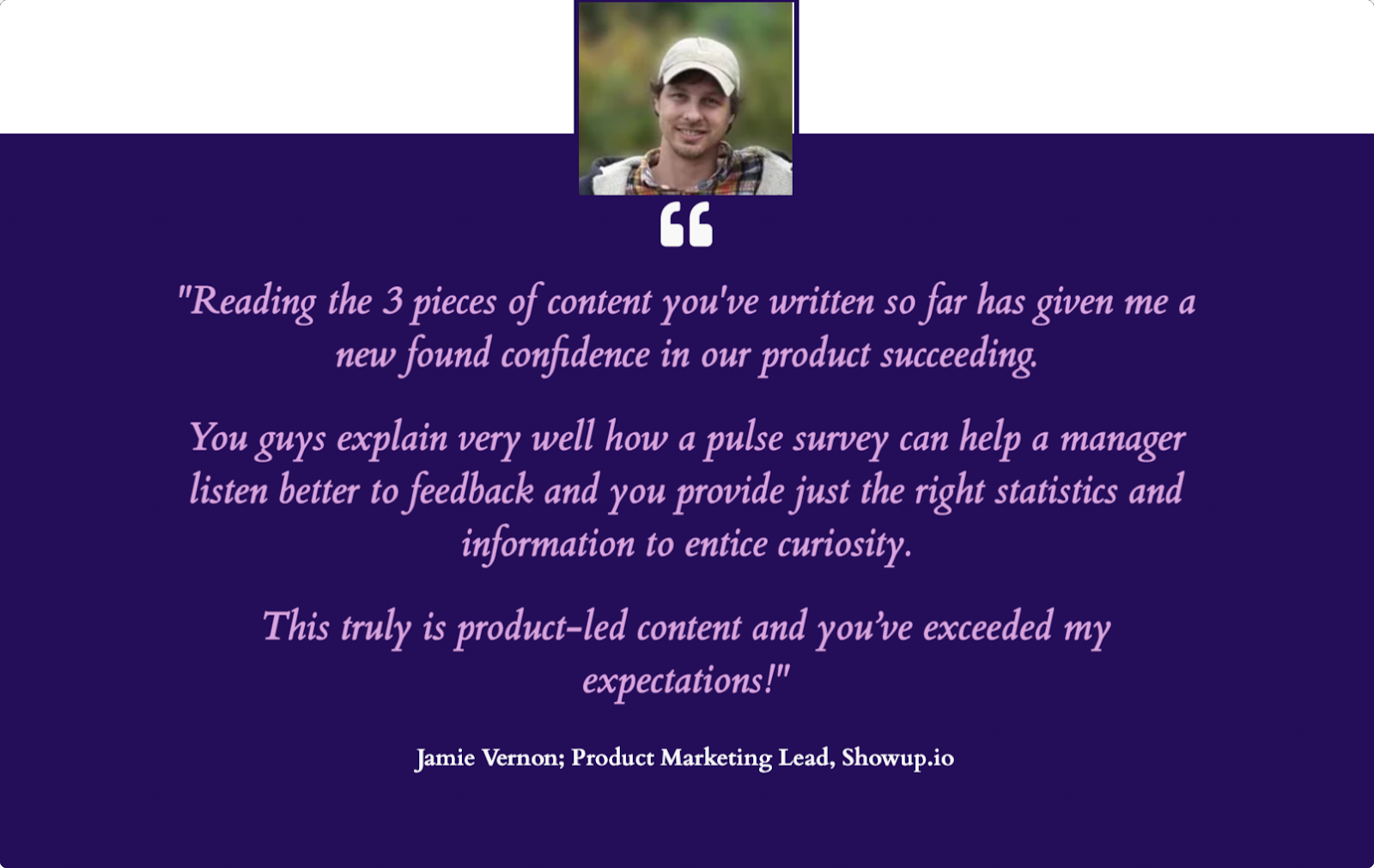
But more importantly, you can get new users, fans, and qualified opportunities directly from crafting product-led stories.
Another client of ours, Andrew Woo, CEO of HoneyCart, commission-free order automation software for drop-off caterers, testifies to this:
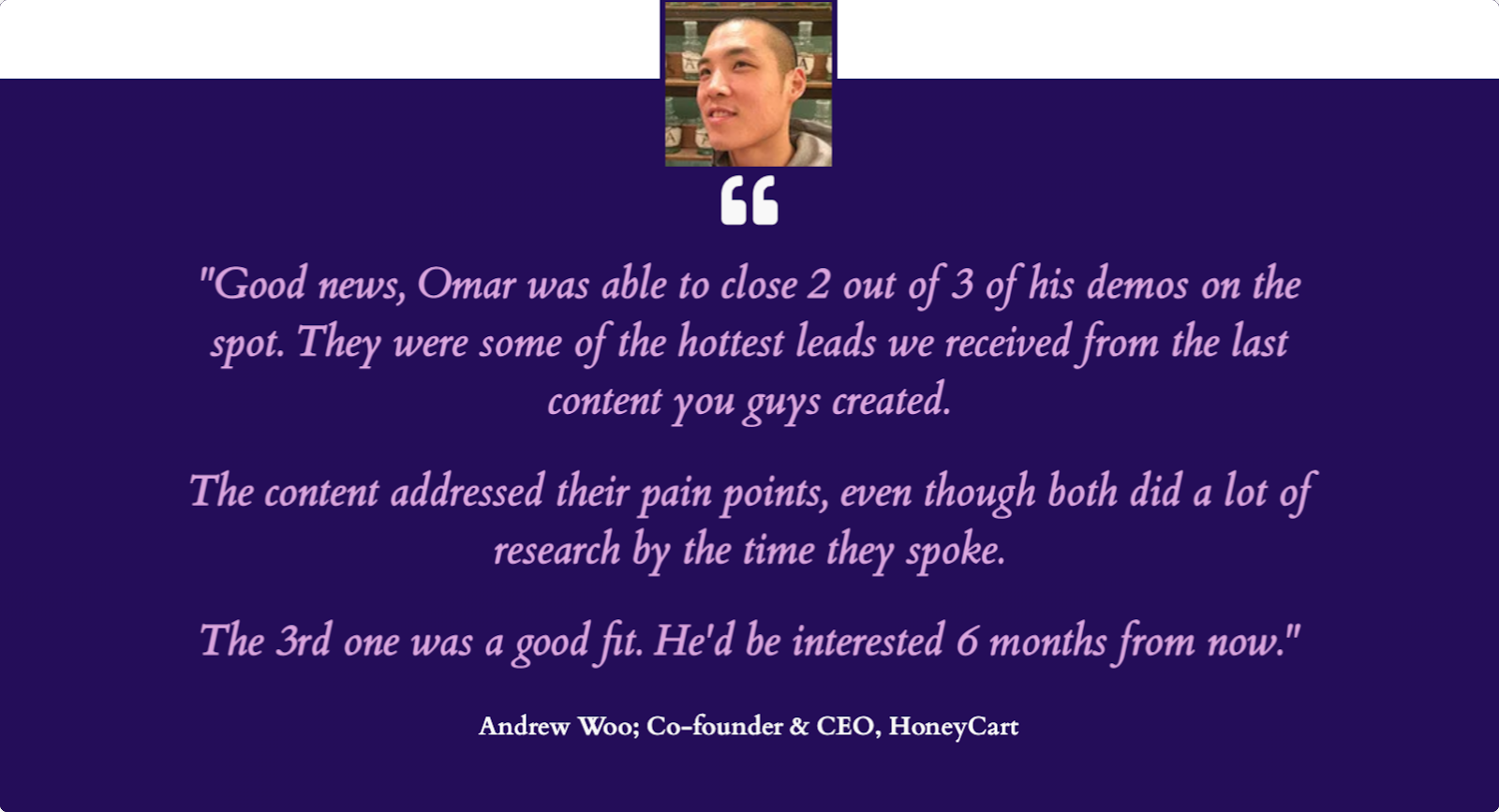
Final Thoughts: Adopting Product-Led Growth Boils Down to Two Things
Product-Led Growth wasn’t created.
Its pattern was identified and coined. Kudos to Blake Bartlett of OpenView Partners for identifying this winning pattern for driving SaaS growth.
And why do I say it wasn’t created, you ask?
Because even before the advent of PLG (or in times past), you couldn’t do business without a product people found valuable (be it consumer or tech).
So, consider the whole idea of adopting PLG more of a mindset shift in the way you market and sell your software product.
This mindset shift is about going back to the basics—how we all buy everyday consumer goods in a crowded market with crowded options.
That mindset is one of seeing before believing, testing before buying.
Today, software buyers want to see how your product works for themselves. They want to test it before they commit to buying. By adopting PLG, you’re adjusting to the mindset prospects now expect of you.
The playbooks I’ve introduced in this guide will arm you with the tools to execute this growth-driving strategy.
And that boils down to two things.
One.
By having a singular focus on what matters most – how the product and users interact together. Use the Product-Led Single Point of Truth for this:

Two.
Craft relatable product-led stories. Doing this helps you attract, engage, and show prospects how to solve their problems with your product.
And don’t forget this.
Spice those stories up with testimonials, reviews, and a slight touch of copywriting, so they transform into sales funnels on their own:

These playbooks will help you adopt a product-led approach that:
- Shortens new user journey,
- Delivers exceptional customer experience, and
- Increases the chances of free (but active users) checking out your pricing plan.

Victor Eduoh
Lead Strategist @VEC
Founder, Lead Strategist @VEC. Thinker, reader, words-crafter, and husband to Omosede. Besides crafting product-led stories, I love scouting and grooming rare marketing talents.
Rare insights, in your inbox
How do SaaS Founders and B2B Content Leaders build brand and drive growth through story-driven content execution? Dig that, plus rare Product-Led Storytelling insights, in this bi-weekly newsletter.
Get a copy of our Story-driven, Content Quality Checklist –FOR FREE– once you subscribe.

